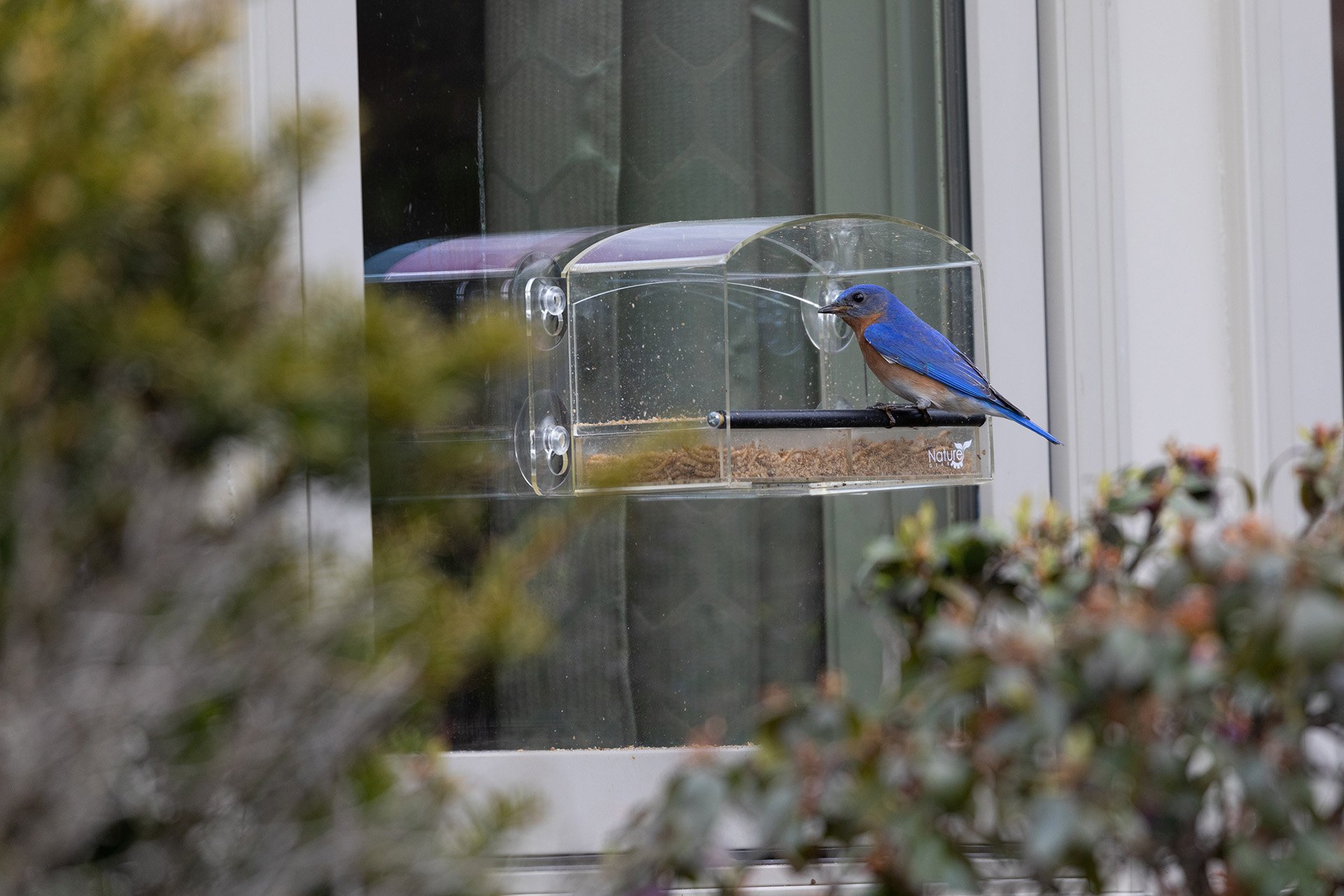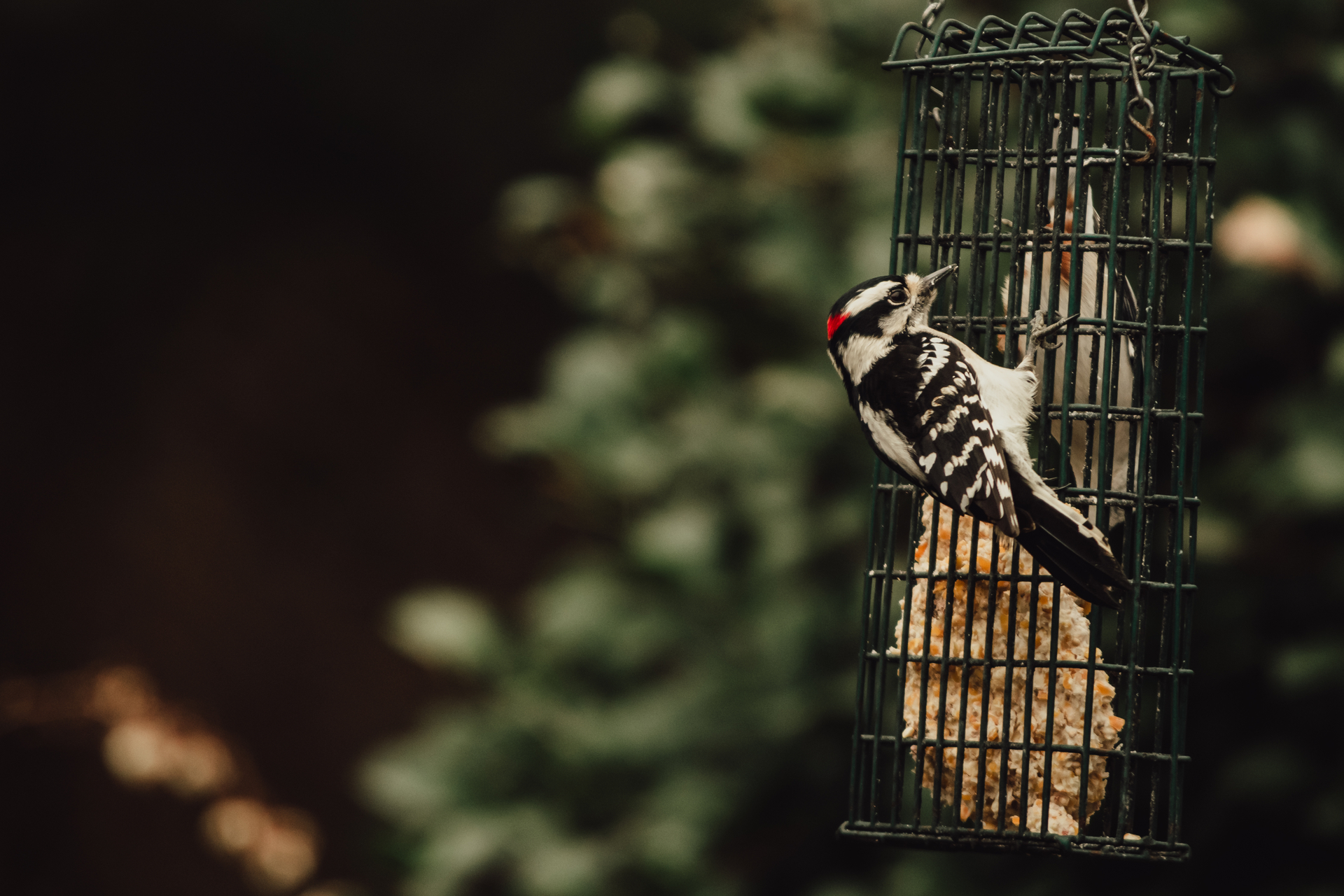Birds in Massachusetts
Bird Feeding Best Practices
The simplest way to learn about the birds in your neighborhood? By bringing them to you! Bird feeding connects you with the behaviors and schedules of local birds without leaving the comfort of your home. Plus, the added food supply supports our feathered friends through rough weather and helps stabilize resources when natural food is scarce.
Discover the ins and outs of bird feeding in Massachusetts with this helpful guide from Mass Audubon.
How to Select the Right Type of Bird Food
Unsure where to start? First things first: selecting the type of food for the type of bird you're hoping to attract.
Different birds prefer different types of seed, but black oil sunflower seeds appear to be the favorite of most bird species, with nyjer (thistle) seed enjoyed by finches. Although mixed seed is cheaper, waste occurs when birds kick the smaller seed onto the ground in search of sunflower seeds.
Never feed birds processed human foods such as bread or crackers. It fills birds up without providing any nutritional value and can result in them not getting the nutrition that they need
Sunflower Seed for Most Seed-eating Birds
There are two types of sunflower seed: black oil and black striped. Black-oil sunflower seeds are more popular with birds than black striped due to the softer shell. Sunflower kernels are the most popular and will attract many species than cannot otherwise manage the shell.
However, Sunflower seeds are also popular with squirrels. If you have more squirrels than birds at your feeder, the Squirrel Buster Classic Feeder has a patented design to keep the critters at bay. When a squirrel grabs a hold of the feeder, the outer cage (or "shroud") lowers to block the feeding ports. What it doesn’t block: a variety of songbirds including cardinals, nuthatches, chickadees, goldfinches and more.
Nyjer Seed for Finches
Nyjer seed is a small, rod-shaped black seed in the sunflower family. It is popular with smaller finches, including charismatic winter finches such as redpolls and Pine Siskins. Specialized feeders have small holes and include tube-style feeders (sometimes labeled as thistle feeders) as well as small bags called “socks.”
Millet for Ground-Feeding Birds
White proso millet is a small, round, yellowish grass seed that is favored by many ground-feeding birds. It can be offered on a platform feeder or scattered on the ground. Be sure to place out no more than can be eaten in a day to prevent it from rotting.
Safflower for Cardinals & Sparrows
Safflower’s hard shell makes it difficult for some birds to get to the meaty center, but it is a favorite among many ground feeding birds like cardinals and sparrows. Its bitter taste makes it unpalatable to squirrels although they can develop a taste for it. It can be placed in a standard feeder, on a platform or scattered on the ground.
Suet for Woodpeckers
Suet is a hard beef fat that is occasionally available from butchers, or in packages of processed suet mixed with seeds or fruit. It is high in calories, which is especially valuable in cold weather. It is loved by most birds but especially by woodpeckers. Suet cages are designed to fit the processed packages and allow birds to easily pick out pieces. Suet is not ideal for summer feeding as it can turn rancid in the heat.
Fruit for Orioles
Many birds will eat fruit, but Baltimore Orioles are especially fond of it. Halved apples or oranges can be impaled on branches or offered in specially designed fruit feeders that have spikes to hold the fruit. Some fruit feeders also have small trays for holding jelly or jam.
A Note on Mixed Seed
Mixed seed often has a large percent of undesirable food, which many birds will simply toss on the ground to get at sunflower seeds and other preferred foods. This can result in a lot of waste, as well as a build-up of rotting seed under the feeder.
Frequently Asked Questions About Feeding Birds
Yes, for two reasons:
- Birds are vulnerable to predators such as cats and hawks, and as a result, they seek feeders that offer the protection of nearby trees or shrubs.
- Squirrels, seem to have an uncanny ability to thwart all attempts to exclude them from feeders. When you are placing a feeder, keep in mind that squirrels can jump six feet up in the air and launch themselves, from a tree or building, to a feeder ten feet away. Feeders placed 12 to 15 feet from trees and shrubs should provide shelter for the birds but discourage squirrels from leaping onto the feeder.
Like the birds we are trying to attract, squirrels are seed eaters and assume that the food is there for them. When you are placing bird feeders in your yard, keep in mind that squirrels can jump six feet straight up in the air and can launch themselves from a tree or building to a feeder ten feet away. Even if the squirrel does not get a foothold, the seed or feeder can be knocked to the ground. The following suggestions may thwart the squirrel:
- Hanging feeders should be suspended from a horizontal wire that is extended between two points. Be sure that there is nothing above the feeder that the squirrels can use as a launching pad. Before attaching the wire, thread each end through five-foot sections of smooth plastic or metal pipe, 4 or 5 inches in diameter. The pipe will rotate when the squirrel attempts to cross to the feeder, causing the squirrel to fall to the ground, unharmed.
- Squirrel baffles, which are usually a metal or plastic dome- or saucer- shaped disk, should be placed above and below a pole feeder. A successful baffle is one that the squirrel cannot cling to, climb over or around, or gnaw through. Mount baffles loosely so they readily tip if a squirrel lands on them.
- Many squirrel-proof feeders are available and are largely effective.
Store the seed in a cool, dry place in an area out of the reach of rodents. Aluminum trash cans with tight-fitting lids are ideal rodent-proof containers for seed.
High concentrations of birds in close proximity to one another can contribute to the spread of disease at bird feeders. All feeders should be cleaned and disinfected on a regular basis (every 2 weeks) with a solution of one part bleach to nine parts water. All surfaces should be rinsed well and thoroughly dried before refilling.
When sick birds do appear at feeders, it is best to take down the feeders for a period of 2 weeks so that no other birds become contaminated. Disinfect feeders and remove hulls and uneaten seeds from ground-feeding areas.
The instinct to migrate is largely hard wired, so the availability of an artificial food source has no impact on migration.
No, studies have shown that most birds depend on our handouts for only about 25 percent of their food. Our feeder offerings only supplement their natural foods. When a food supply disappears in one location, they will move on and look for other sources.
In communities in central and western Massachusetts inhabited by black bears, we recommend that bird feeders and suet feeders should be removed from yards between March and November, the months when black bears are active. Some bears can remain active in winter if food is available, so if you see signs of bear activity you should remove your feeders.
For communities where it is safe to feed year-round, it is more important than ever to keep feeder areas clean in warm weather. This includes the ground under the feeder where accumulated seed can spoil and harbor disease.
In the summer, a water source will be heavily used by birds for drinking and bathing, and parent birds will bring their young to the water for their first baths. Water tends to be scarcest in the winter so a source of unfrozen water is much appreciated by winter birds. If your bird bath is deeper than 2”, try adding small rocks or gravel to form perches for smaller birds. Baths should be cleaned frequently with a solution of one part bleach to nine parts water can be used to clean and disinfect the bath. In the winter, baths can be kept open either by frequent refilling or with an electric heater designed for that use. Never use glycerin in the birdbath to keep water from freezing; it is toxic if ingested and can destroy the insulating properties of feathers!
A number of Massachusetts' hawk species prey on birds at feeders (most notably Sharp-shinned and Cooper's hawks). Predation is a natural occurrence in the lives of wild birds and mammals. Mortality is normally very high in most bird populations and predation is a mechanism important in maintaining populations that the environment can support. When people feed birds, they create an artificial environment, drawing large numbers of birds to one location, usually right outside a window. People who are upset by the presence of a hawk near a feeder should stop putting out seed for a few weeks to encourage it to look elsewhere for food.

Bring More Birds to Your Backyard
Discover thoughtfully designed bird feeders that help local birds thrive.
Upcoming Birds & Birding Programs
See all programsWednesday Morning Birding
-
Newburyport and vicinity
-
Wednesday, December 31
9:30am-12:30pm
Adults
New Year's Day Birdwatching
-
Ipswich River Wildlife Sanctuary, Topsfield
-
Thursday, January 1
8:00-11:00am
Adults
New Year's Day Birdwatching
-
Joppa Flats Education Center, Newburyport
-
Thursday, January 1
8:00-11:00am
Adults
Stay Connected
Don't miss a beat on all the ways you can get outdoors, celebrate nature, and get involved.



